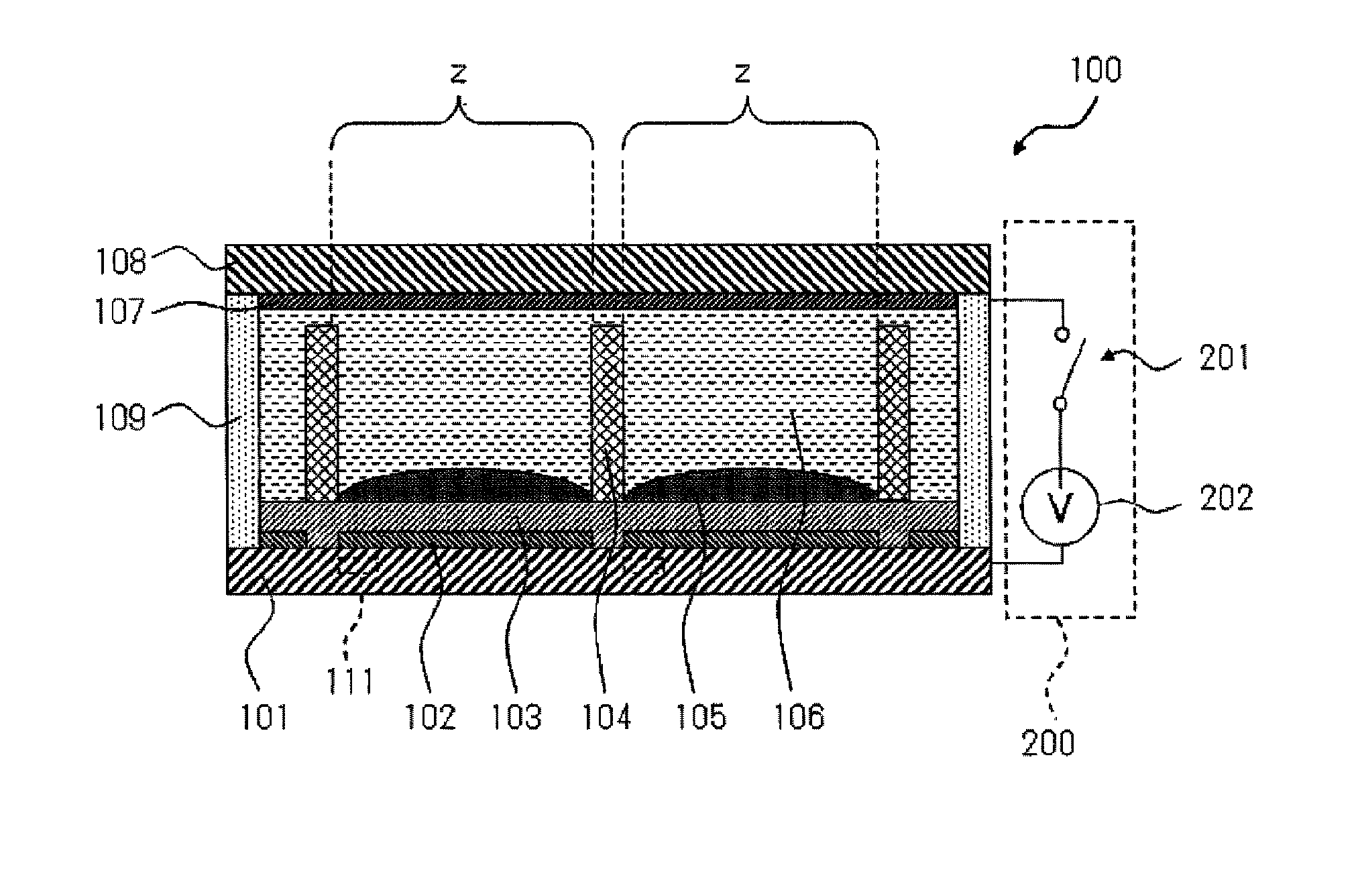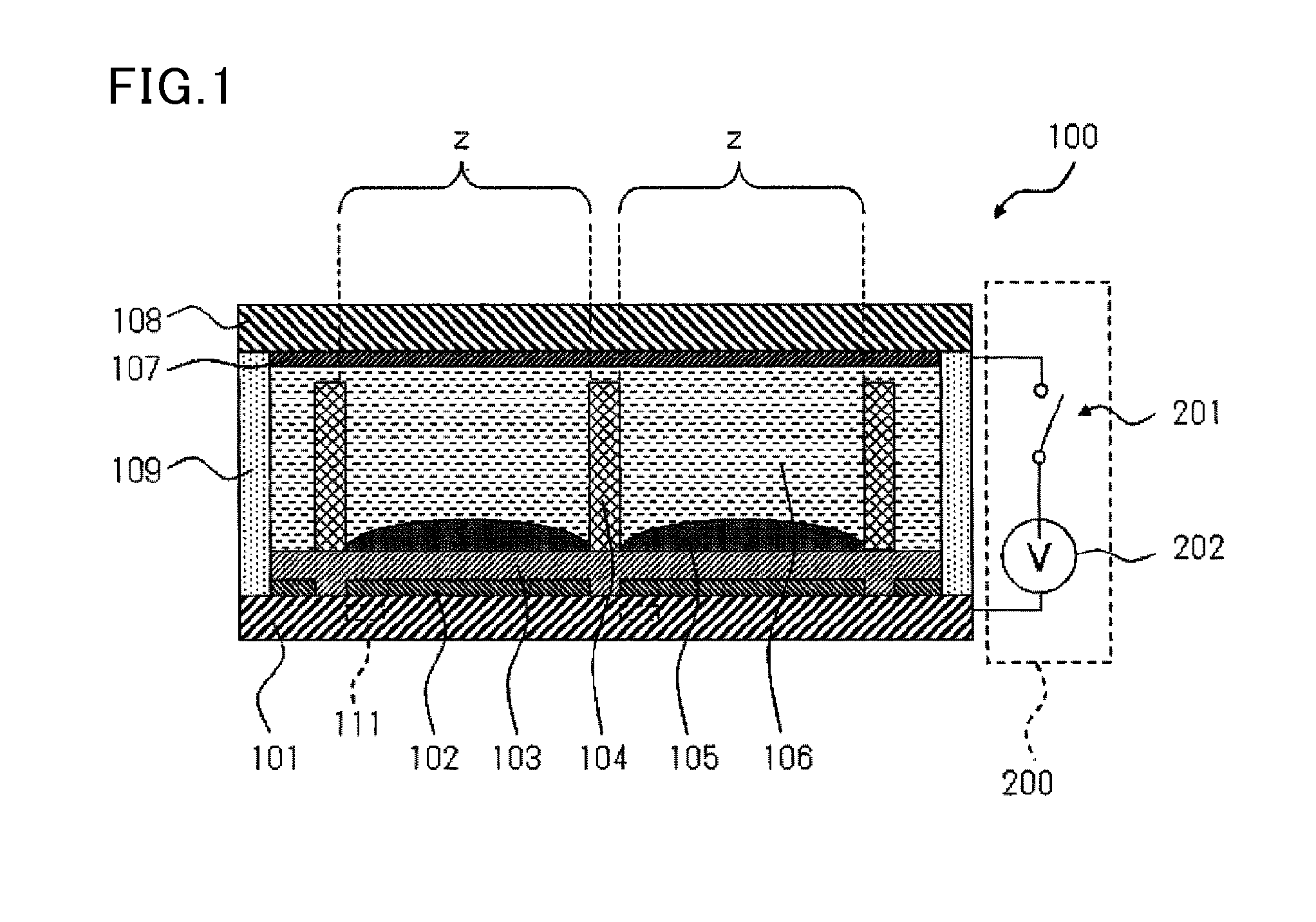High dielectric film
a dielectric film, high-efficiency technology, applied in the direction of fixed capacitor details, fixed capacitors, instruments, etc., can solve the problems of high electric energy consumption of devices, electrical breakdown, and inhibit the practical use of electrowetting devices, and achieve low dissipation factor and high dielectric constant
- Summary
- Abstract
- Description
- Claims
- Application Information
AI Technical Summary
Benefits of technology
Problems solved by technology
Method used
Image
Examples
synthesis example 1
Production of VdF / TFE Copolymer (a1)
[0277]A 4-L-capacity autoclave was charged with 1.3 kg of pure water, and sufficiently purged with nitrogen. Then, 1.3 g of octafluorocyclobutane was put thereinto, and the inside of the system was maintained at a temperature of 37° C. and at a stirring rate of 580 rpm. Thereafter, 200 g of a gas mixture of tetrafluoroethylene (TFE) / 1,1-difluoroethylene (vinylidene fluoride, VdF) (=7 / 93 mol %) and 1 g of ethyl acetate were put into the autoclave. Further, 1 g of a 50% by mass solution of di-n-propyl peroxydicarbonate in methanol was added thereto, initiating the polymerization. Since the pressure in the system decreased in response to the progress of the polymerization, a gas mixture of tetrafluoroethylene / 1,1-difluoroethylene (=7 / 93 mol %) was continually supplied to the reaction system so as to maintain the pressure in the system at 1.3 MPaG. The stirring was continued for 20 hours. The pressure was then released to atmospheric pressure, and the...
synthesis example 2
Production of VdF / TFE Copolymer (a2)
[0278]A 4-L-capacity autoclave was charged with 1.3 kg of pure water, and sufficiently purged with nitrogen. Then, 1.3 g of octafluorocyclobutane was put thereinto, and the inside of the system was maintained at a temperature of 37° C. and at a stirring rate of 580 rpm. Thereafter, 200 g of a gas mixture of tetrafluoroethylene (TFE) / 1,1-difluoroethylene (vinylidene fluoride, VdF) (=20 / 80 mol %) and 1 g of ethyl acetate were put into the autoclave. Further, 1 g of a 50% by mass solution of di-n-propyl peroxydicarbonate in methanol was added thereto, initiating the polymerization. Since the pressure in the system decreased in response to the progress of the polymerization, a gas mixture of tetrafluoroethylene / 1,1-difluoroethylene (=20 / 80 mol %) was continually supplied to the reaction system so as to maintain the pressure in the system at 1.3 MPaG. The stirring was continued for 20 hours. The pressure was then released to atmospheric pressure, and t...
synthesis example 3
Production of VdF / TFE Copolymer (a3)
[0279]A 4-L-capacity autoclave was charged with 1.3 kg of pure water, and sufficiently purged with nitrogen. Then, 1.3 g of octafluorocyclobutane was put thereinto, and the inside of the system was maintained at a temperature of 37° C. and at a stirring rate of 580 rpm. Thereafter, 200 g of a gas mixture of tetrafluoroethylene (TFE) / 1,1-difluoroethylene (vinylidene fluoride, VdF) (=18 / 82 mol %) and 1 g of ethyl acetate were put into the autoclave. Further, 1 g of a 50% by mass solution of di-n-propyl peroxydicarbonate in methanol was added thereto, initiating the polymerization. Since the pressure in the system decreased in response to the progress of the polymerization, a gas mixture of tetrafluoroethylene / 1,1-difluoroethylene (=18 / 82 mol %) was continually supplied to the reaction system so as to maintain the pressure in the system at 1.3 MPaG. The stirring was continued for 20 hours. The pressure was then released to atmospheric pressure, and t...
PUM
| Property | Measurement | Unit |
|---|---|---|
| average primary particle size | aaaaa | aaaaa |
| mol % | aaaaa | aaaaa |
| mol % | aaaaa | aaaaa |
Abstract
Description
Claims
Application Information
 Login to View More
Login to View More - R&D
- Intellectual Property
- Life Sciences
- Materials
- Tech Scout
- Unparalleled Data Quality
- Higher Quality Content
- 60% Fewer Hallucinations
Browse by: Latest US Patents, China's latest patents, Technical Efficacy Thesaurus, Application Domain, Technology Topic, Popular Technical Reports.
© 2025 PatSnap. All rights reserved.Legal|Privacy policy|Modern Slavery Act Transparency Statement|Sitemap|About US| Contact US: help@patsnap.com



